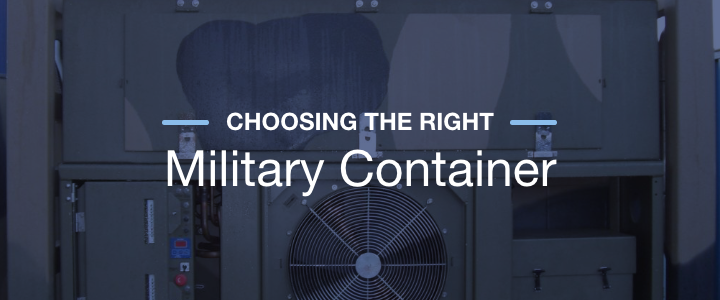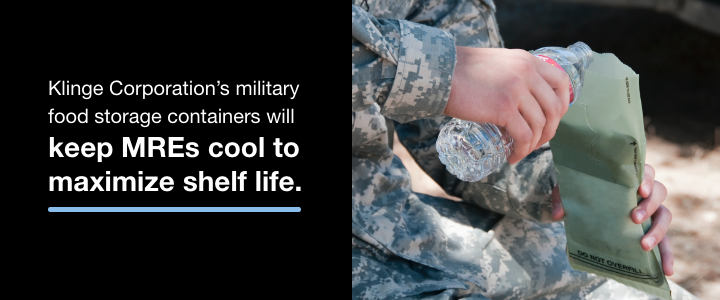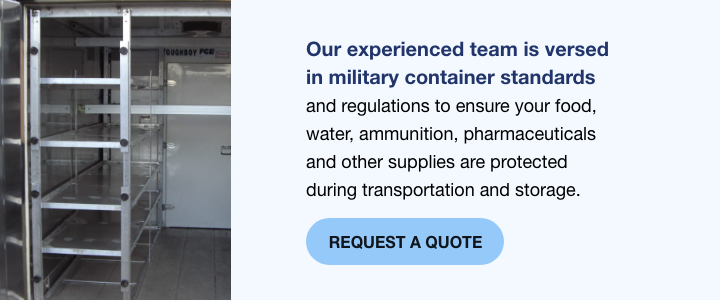
Military operations require specialized containers to protect supplies like food, water and medical goods. Often, they require refrigerated storage and Military containers for shipping, also called reefer units. These containers meet military regulations and standards and can withstand harsh conditions.
Choosing the right military container starts with assessing your specific needs. Do you need to transport medical supplies at sub-zero temperatures? Or, do you need to transport and store food and water and want to prevent cross-contamination? You’ll need to select a container that will fulfill your specific needs.
Below, we’ll explore how military containers are different from other containers and which military shipping containers are best for storing and shipping food and water and medical supplies.
Table of Contents
- How Are Military Containers Different From Other Containers?
- Army MRE Storage and Shipping Regulations
- Storing and Shipping Medical Supplies
- Contact Klinge Corporation for Military-Grade Containers
How Are Military Containers Different From Other Containers?
Military storage and shipping containers are built to safely transport medicine and food long distances and in tough conditions, such as excessive heat or explosive environments. Many military storage containers are refrigerated units, also called reefer containers. These containers are designed to control airflow and humidity while keeping goods at a consistent temperature. Reefer containers contain components such as internal fans, a control unit to adjust the temperature, a unit evaporator to manage moisture and condensers for proper airflow.
Reefers are an essential part of cold chain transportation. The cold chain process is a variation of the standard supply chain, in which products are transported at a controlled temperature. In military operations, products are often shipped long distances in excessively hot environments, complicating the cold chain process. The amount of time a product can be stored increases as storage temperatures drop, so it’s important to know what temperature different goods require for transport.
Cold chain shipping has five classifications:
- Fruits: Tropical fruits like bananas, pineapples and oranges ripen during the shipping process and require a storage temperature between 12° and 14° C (54° to 57° F).
- Pharmaceutical: Medicines and other pharmaceutical goods are often kept at a temperature between 2° and 8° C (36° to 46° F).
- Chill: This classification is used for fruits, vegetables and meats that usually require a storage temperature between 2° and 4° C (36° to 39° F).
- Frozen: As its name suggests, the frozen classification keeps foods like frozen meats, cakes and bread between -10° and -20° C (-4° to 14° F).
- Deep-frozen: The coldest classification, deep-frozen, is the coldest shipping temperature to keep goods like seafood and ice cream from perishing. Transport temperatures range from -25° to -30° C (-22° to -13° F) and even down to -70°C (-94°F) for some applications.

Army MRE Storage and Shipping Regulations
In the military, MRE stands for Meal, Ready to Eat and is the standard food and nutrition source for troops that are outside the range of mess facilities. MREs are designed to withstand harsh conditions without perishing. However, an MRE that’s kept in 49°C (120° F) temperatures will only last about a month. On the other hand, an MRE stored at a temperature of 27°C (80° F) will last about three years, and shelf life can be maximized in colder temperatures, so it’s important to store MREs at a proper temperature.
Klinge Corporation’s military food containers will keep MREs and other foodstuffs cool to maximize shelf life. Klinge’s 20 ft Dual Temp Zone Refrigerated Military Container has a moveable bulkhead to divide the container into separate refrigeration and freezing zones to minimize cross-contamination. A diesel generator set powers the unit, which meets military standards such as vibration testing, Category A1 and B2 cooling, and driving rain testing. With this container, you’ll be able to safely ship products that require multiple temperatures.
Storing and Shipping Medical Supplies
Proper storage is crucial for vaccines and other medical supplies. Reefer containers made for medical supplies coupled with a well-trained staff can save money and protect life-saving pharmaceutical goods. In 1998, more than 200,000 doses of the Anthrax vaccine were damaged because of freezing. Correct storage and attention to proper cold-chain processes could have prevented this loss.
The U.S. Pharmacopeia has three temperature standards for pharmaceutical products:
- Refrigerated Storage: Refrigerated storage keeps goods between 2° C and 8° C (35° F to 46° F).
- Frozen Storage: Frozen storage is for goods that need to be kept between -20° C and 10° C (-4° F to 14° F).
- Room Temperature: Room temperature is the warmest classification. It keeps goods between 20° C and 25° C (68° to 77° F).
Pharmaceutical products are also sensitive to light, humidity and vibration. Proper storage equipment is necessary to protect vulnerable medical supplies. Pharmaceutical-grade containers should have a strong shield and air circulation from multiple fans to keep the temperature consistent. Pharmaceutical reefer containers also allow you to monitor their temperature during transportation to ensure valuable medical supplies don’t spoil.
For medical supplies that need to be kept at a temperature between -25° C and -5° C (-13° F to 23° F), use Klinge’s Dual Redundant Refrigeration Unit & Integral Genset. The two units are complete and separate while still communicating with each other. The refrigeration system offers total protection in case of failure and will activate the backup if need be. You’re also able to remotely monitor the system’s temperature throughout the duration of transportation.
Other pharmaceuticals, like vaccines, biologics or blood plasmas, require colder temperatures. These medical supplies should be kept in Klinge’s -65° C Deep Freeze Container, which ranges from -65° C to 0° C (-85° F to 32° F). This unit is equipped with an evaporator fan motor and fan to ensure adequate airflow. The unit can also act as a blast freezer and has an integral generator set for backup power and dual versions of a similar system are also available in temperatures down to -70°C (-94°F).

Contact Klinge Corporation for Military-Grade Containers
For nearly four decades, Klinge Corporation has been providing reliable military shipping and storage containers to customers. Our experienced team is versed in military container standards and regulations to ensure your food, water, pharmaceuticals and other supplies are protected during transportation and storage.
Request a free quote or contact a Klinge Corporation specialist to learn more about our military containers, as well as our other container options, such as cooling containers, refrigerated tanks, shipping freezer containers and temperature-controlled pharmaceutical containers.
